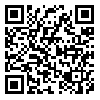BibTeX | RIS | EndNote | Medlars | ProCite | Reference Manager | RefWorks
Send citation to:
URL: http://jstnar.iut.ac.ir/article-1-3194-en.html
The most important cause of concern about the stability of bridge foundation is the occurrence of scour around bridge piers. Therefore, different methods have been proposed to prevent or reduce scouring around bridge piers. The use of groynes is one of the modern methods to control and reduce local scour. In the present study, the effect of a solid groyne on reduction of the scour depth around a cylindrical bridge pier, located in the bend of a laboratory flume is assessed. Experiments were conducted for groyne model angled at 50˚, 90˚ and 120˚ to the downstream channel sidewall with three flow rates of 47, 49 and 51 liters per second in a sediment free condition. Results showed that in at ratios of velocity to critical velocity and all groyne angles, in comparison with no groyne, the scour depth was reduced. At all ratios of velocity to critical velocity, the best operation was related to normal groyne and the average operation of repelling groyne was better than attracting groyne. The operation of normal groyne decreased and attracting groyne function improved as the flow rate increased. Also, the normal groyne (ratio of velocity to critical velocity equal to 0.87) had the best effect on reducing the scour depth (by about 71.4 percent).
| Rights and permissions | |
 |
This work is licensed under a Creative Commons Attribution-NonCommercial 4.0 International License. |






